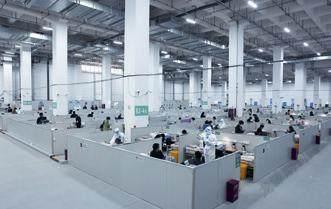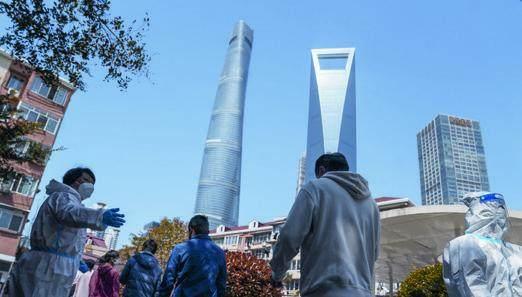Shanghai:Resilience In the Face of Resurgence
By Thomas W.Pauken II
Amid the numerous challenges Shanghai residents must contend with to curb the spread of the COVID-19 Omicron variant, the city will eventually see glimmers of hope and locals can return to business as usual. But for the moment, and likely the weeks to come, Shanghai, one of Chinas most populous cities and the nations financial hub, still struggles under strict social distancing and quarantine procedures.
According to public health figures released on April 7, the city reported 19,660 asymptomatic cases and 322 confirmed symptomatic cases within 24 hours. For the record, the medical term“asymptomatic” infers a patient tested positive for the virus, but showed no visible symptoms.
Public health officials have implemented citywide measures to impose mandatory nucleic-acid testing and this could partially explain the rise in numbers. Its a real game of numbers: The more people get tested, the more chance more locals test positive. But there is a bright side: Few people are getting seriously ill, despite this Omicron wave bringing tens of thousands of asymptomatic cases to Shanghai.
The latest resurgence first hit Jilin Province, then Shenzhen in Guangdong Province, and now Shanghai. Only two persons had died in Jilin, on March 18, and these were elderly patients already suffering from an unrelated chronic illness. Nonetheless, the Shanghai Municipal Government was on high alert.
Lockdowns and quarantines
The Chinese Government fully understood that enforcing a citywide shutdown to tackle COVID-19 could cause a sharp drop in Chinas domestic economic activity given the megalopolis is home to the Shanghai Stock Exchange and the Shanghai Gold Exchange, and serves as the regional Asia-Pacific headquarters of major multinationals.

Accordingly, on the evening of March 27, local officials announced plans to implement tough lockdown measures—in phases. The city is divided by the eastern and western half with the Huangpu River running across as the dividing line. Pudong New Area, representing the eastern half, went into lockdown from March 28.
The western half of the city then entered a quarantine phase from April 1 to April 5. The lockdowns also entailed the closure of all non-essential shops and public facilities. Locals could not use public transportation in restricted zones and people could not leave their compounds unless they were employed in jobs related to law enforcement, public health, government, logistics or e-commerce delivery.
Many Pudong residents have seen their quarantines prolonged, if they reside in the same apartment building or compound as COVID-19 patients.
Tough as these conditions may seem, Shanghai is a thriving city and bears the capacity to endure. When the quarantines come to an end, we can anticipate a fast rebound.
Containing impact
Theres no denying that Shanghai, and even the entire country, will face a deep economic impact for the short to mid-term outlook. The government continues to adhere to its dynamic zero-COVID-19 policy, meaning Chinese public health officials will immediately take the necessary measures to curb the spread of infection.
Shanghai has one of the busiest international shipping ports in the world. The city has many factories and warehouses located in the China (Shanghai) Pilot Free Trade Zone and they were placed there to boost foreign trade activities. China is, after all, the worlds leading manufacturer and exporter.
Accordingly, the Caixin/Markit Manufacturing Purchasing Managers Index in China dropped from 50.4 in February to 48.1 in March. Its the steepest drop the nations factory activity has seen in one month since February 2020, when China entered a partial lockdown phase to tackle COVID-19.
But other factors are at play to explain Chinas impending drop in manufacturing and exports. Shenzhen, another one of the countrys most important trading hubs, was hit by a COVID-19 resurgence in early March, resulting in city-wide business closures.
The Russia-Ukraine conflict, too, is bound to weaken global demand for Chinese exports for the rest of the year. The North American and European markets will be most affected as U.S.-led sanctions against Russia will result in severe supply chain disruptions, sky-high inflation rates, as well as impending energy and food shortages that could lead to a global recession or depression in the second half of the year.
Shanghais temporary halt in business activities could be a matter of good timing as the citys current lower gas demand has caused gas prices to drop nationwide. And so we see light at the end of the tunnel.
The road to recovery
The Chinese Center for Disease Control and Prevention (China CDC) has already taken important notes from the latest Shanghai flare-up. Local officials have given the green light for increased imports of new vaccines and therapeutic drugs, while the Shanghai Municipal Government has offered to provide more subsidies to small businesses and introduce more preferential tax treatments and policies.

According to the Global Times, Zeng Guang, former chief epidemiologist of the China CDC, said that China is indeed facing a “tough battle,” but there have been few reported deaths and, in both cases, they were“co-morbidity,” meaning the patients already suffered from life-threatening ailments before getting diagnosed with the virus.
Shanghais hospitals and emergency medical treatment facilities did not see a huge uptick in COVID-19 patients requiring urgent care. Therefore, Zeng believes that its “time for the country to explore ways to cope with large-scale outbreaks.”
Yet we should not anticipate the authorities to make dramatic adjustments to the dynamic policy in the near future. The Chinese Government has taken a people-centered approach to confronting the pandemic. And just imagine if the nations public health officials had taken a more light-hearted approach; the new COVID-19 cases and death rates could have hit a catastrophic high.
Lockdowns and quarantines arent easy on anyone, Chinese citizens included, but by adhering to rigorous measures, China will emerge stronger and healthier than ever before. BR

